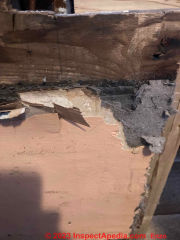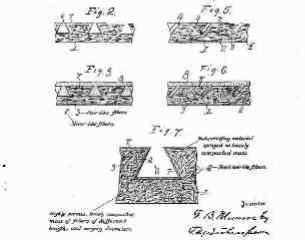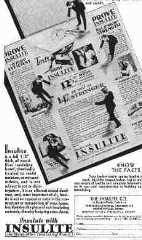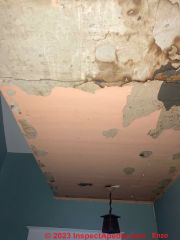 Graylite / Insulite Fiberboard Identification
Graylite / Insulite Fiberboard Identification
Building Wall & Roof Sheathing, Insulating Board Identification
- POST a QUESTION or COMMENT about Insulite or Graylite fiberboard building sheathing: how to identify Insulite fiberboard products, fiberboard uses, Graylit efiberboard, does Insulite fiberboard contain asbestos?
Graylite & Insulite fiberboard insulating sheathing & wallboard or ceiling board product identification guide.
Page top photo: this gray papery wallbaord might be a Graylite product as described on this page.
In this article series we provide fiberboard product names and we describe the components, properties, and applications of various fiberboard, hardboard, and insulating board or sound deadening board products.
InspectAPedia tolerates no conflicts of interest. We have no relationship with advertisers, products, or services discussed at this website.
- Daniel Friedman, Publisher/Editor/Author - See WHO ARE WE?
Identify Graylite - Insulite, Cellulose FiberBoard Insulating Board & Plaster Base
 Insulite Fiberboard History: Carl G. Muench
Insulite Fiberboard History: Carl G. Muench
Insulite was a cellulose-based (all wood fiber) insulating board or sheathing material that, unlike Celotex, was made from wood pulp byproduct or tailings fibers.
Insulite was patented by Carl G. Muench who founded the Ontario Paper Company in 1914 (Gould 2014), and who started manufacturing Insulite, billed as "the first rigid insulating board", in International Falls, Minnesota, first patented in 1915 (Jester 2014)
[Click to enlarge any image]
The Insulite board was treated to "... resist moisture, vermin and rodents" and also was sold as a "sound deadener"[10] and in some applications the product was installed in the air space between gypsum board partitions to improve sound isolation between building areas.
Insulite was described as having stronger structural properties than Celotex, the latter being superior for insulation and sound insulation while Insulite offered greater strength for other applications. Insulite was
... composed of large sliver-like particles often 1/16" to 1/32" in width and say one half an inch long. These sliver like fibers give great porosity to the mass but they render the binding together of the particles more difficult. [10]
Insulite as a plaster board contained rabbeted grooves or "joints" in its surface to which plaster or other material could be applied. Insulite's name for this product was Lok-Joint Lath
Insulite ingredients included a composition of plaster of paris, cement, or other like substance, combined with hair, wood fiber, sawdust, wool, wood shavings, excelsior, straw, or similar substances. (Asbestos was not cited in the product description. )[11]
Dahlberg (St. Paul MN and Celotex, Chicago IL in this early patent U.S. No. 1,333,628, described a plaster-board of fibrous material intended to provide a less costly base for plaster walls and ceilings.
 This was the earliest citation of "Insulite" that we could find. It improved on the original "insulite" construction by including additional long fibers for strength combined with more short fibers to serve as filler for the mass, developing a board that was light weight, had adequate strength, and included entrained air for improved insulation.
This was the earliest citation of "Insulite" that we could find. It improved on the original "insulite" construction by including additional long fibers for strength combined with more short fibers to serve as filler for the mass, developing a board that was light weight, had adequate strength, and included entrained air for improved insulation.
This invention, instead of impregnating the insulating board with a waterproofing compound, simply coated its surface. The result was a product [intended and claimed to be] well suited for use as plasterboard.
Sound absorbing board for walls and ceilings", Patent No. 1,554,180, issued to W.S. Trader, September 15,1925, first disclosed a wallboard constructed from "Celotex", a felted mass of strong bagasse fibers, so compacted as to be capable of use as an artificial lumber in that it can be sawed and nailed, and has sufficient strength in many cases to be substituted for lumber.
That same patent mentions "Insulite", a building board made from wood pulp tailings and which likewise has a porous fibrous body portion and which is possessed of considerable strength so that the same can be nailed, etc.
Celotex was preferred as an insulating material because its internal cells produce a sound-deadening insulating effect.
More details about Graylite and Insulite are found in this article:
FIBERBOARD PLASTER BASE SYSTEMS
- Gould, Carol S., Kimberly L. Konrad, Kathleen Catalono MIlley, Rebecca Gallagher, "FIBERBOARD Dates of Production 1858 to the present, Common Trade Names" [American Wallboard, Beaver Board, Cornell Board, C-X Boards, Feltex, Fir-Tex, Homasote, Insulite, J-M Board, Maftex, Masonite (presdwood Quartrboard, Tempered Presdwood), Nu-Wood, Upson Board), Chapter 12 in Jester, Thomas C., ed. Twentieth-century building materials: History and conservation. Getty Publications, 2014.
- Whittemore, Herbert L., and Ambrose H. Stang, BUILDING MATERIALS and STRUCTURES Report BMS31 [PDF] (1939) U.S. Department of Commerce,
Structural Properties of "INSULITE" Wall and "Insulite" Partition Constructions, Sponsored by the Insultite Co. - [11] "Insulite Co. v. Reserve Supply Co.," 60F.2d 433 (1932), Circuit Court of Appeals, Eighth Circuit, July 26, 1932. Web Search t/23/12. Quoting:
Rabbeted joints in material to which plaster or other material is applied are found in the Jones patent, No. 886,813. In this patent the composition is made up of plaster of paris, cement, or other like substance, combined with hair, wood fiber, sawdust, wool, wood shavings, excelsior, straw, or similar substances.
The length of the lath covers three joists instead of four. The boards are arranged in staggered relation to each other and the joints are shiplapped.
The specification states that after the boards or blocks are placed in position they may be covered with wallpaper or other similar material, which, of course, would include plaster.- "Machine for perforating Insulite Boards", U.S. Patent No. 1,306,283, Patented 10 June 1919, John K. Shaw, inventor from Minneapolis MN, describes improvements for machines for perforating Insulite Boards.
- "Before you Build write for this mailing piece and a sample of Insulite", [advertisement], The Literary Digest, 13 September 1940.
- Muench, Carl G. "Felting-machine." U.S. Patent 1,187,476, issued June 13, 1916.
- Muench, Carl G. "Indented fiber board." U.S. Patent 1,417,552, issued May 30, 1922.
- Muench, Carl G. "Concrete building construction." U.S. Patent 1,417,553, issued May 30, 1922.
...
Reader Comments, Questions & Answers About The Article Above
Below you will find questions and answers previously posted on this page at its page bottom reader comment box.
Reader Q&A - also see RECOMMENDED ARTICLES & FAQs
On 2023-01-22 by InspectApedia Publisher (mod) - "Deadening Felt" - gray paper-like wall/ceiling covering in a 1908 US Home - Graylite?
@Enzo,
That looks like a gray paper-type wall sheathing product, typically used as an insulating sheathing or underlayment. Often used as a plaster base.
First take a look at
IDENTIFY Insulite, or Graylite cellulose fiber board product useful for plasterboard - above on this page as I think that's probably what's in your home.
In these articles you'll see "grayboard", "greyboard", and "buffaloboard" or "buffalo board" sheathing.
That product is detailed at
BEAVERBOARD IDENTIFICATION
It's a bit odd to see continuous shiplap boards behind it unless that wall was once an exterior wall of the building. Is that possible?
About repairing that wall, in my opinion "repair" isn't practicable nor cost-effective. I'd either remove the old material down to shiplap boards or cover it all with a layer of drywall. If you're adding drywall and want to minimize wall thickness (so as to avoid having to re-do interior trim), maybe 1/4" thick drywall would work.
Above we have added your second photo from your link.
See examples of similar paper-based wallboard used on walls and ceilings, often as a plaster base, described at:
DRYWALL TYPE IDENTIFICATION STAMPS
DRYWALL & GYPSUM BOARD COMPOSITION & HISTORY - composition of drywall & drywall history
PLASTER TYPES & METHODS in BUILDINGS
On 2023-01-22 by Enzo - What is this wall covering in our 1908 USA house?
Hello!
What is this wall covering in our 1908 USA house?
We are working on a house built in 1908 in the USA and have found what a local old-timer called “deadening felt” attached to the walls, which are shiplap. The internet returns nothing for deadening felt!
Whatever it is, it looks as if it was painted right onto, and you can see the vertical seams on the walls. There may be a very thin skim coat of plaster on there...or just years of paint. It has not molded even though we are in a wet climate.
We found this post on stack exchange as a clue, but it doesn’t quite fit the bill: Proper way to repair old plasterboard walls? .
Does anyone know what this type of wall covering is? What are the chances it has asbestos? How do folks typically remove this covering, or do they?
We posted on the DIY StackExchange with more photos and are cross-posting here since ya'll have quite a bit of knowledge on materials: https://diy.stackexchange.com/questions/265208/what-is-this-wall-covering-in-our-1908-usa-house
...
Continue reading at FIBERBOARD PLASTER BASE SYSTEMS or select a topic from the closely-related articles below, or see the complete ARTICLE INDEX.
Or see these
Recommended Articles
- MDF Medium-Density Fiberboard DEFINITION & CHARACTERISTICS
- SHEATHING, FIBERBOARD - home
- DEFINITION of FIBERBOARD SHEATHING
- FIBERBOARD CEILING & WALL COVERINGS
- FIBERBOARD MANUFACTURERS & BRAND NAMES
- FIBERBOARD PANEL REPAIR
- FIBERBOARD PLASTER BASE SYSTEMS
- FIBERBOARD SHEATHING ASBESTOS CONTENT
- FIBERBOARD SHEATHING FIRE RATINGS
- FIBERBOARD SHEATHING IDENTIFICATION - home
- FIBERBOARD SHEATHING INGREDIENTS
- FIBERBOARD SHEATHING INSECT DAMAGE
- FIBERBOARD SHEATHING MOLD CONTAMINATION
- FIBERBOARD ROOFING & FIBER-WOOD ROOFING
- FIBERBOARD PROTECT from WATER
- HARDBOARD MASONITE™ & OTHER BRANDS
- HARDBOARD & MASONITE USED in WORKS OF ART
- HISTORY of FIBERBOARD INSULATING SHEATHING
- HOMASOTE HISTORY & PRODUCTS
- SHEATHING, FIBERBOARD ASBESTOS CONTENT
- SHEATHING FIBERBOARD CONSTRUCTION
- SIDING HARDBOARD IDENTIFICATION & CLAIMS
- SYNONYMS for FIBERBOARD SHEATHING
- UNIDENTIFIED FIBERBOARD PRODUCTS
- WOOD FIBRE INSULATING PANELS
Suggested citation for this web page
IDENTIFY INSULITE, or GRAYLITE BOARD PRODUCTS at InspectApedia.com - online encyclopedia of building & environmental inspection, testing, diagnosis, repair, & problem prevention advice.
Or see this
INDEX to RELATED ARTICLES: ARTICLE INDEX to BUILDING STRUCTURES
Or use the SEARCH BOX found below to Ask a Question or Search InspectApedia
Or see
INDEX to RELATED ARTICLES: ARTICLE INDEX to BUILDING INTERIORS
Or use the SEARCH BOX found below to Ask a Question or Search InspectApedia
Ask a Question or Search InspectApedia
Try the search box just below, or if you prefer, post a question or comment in the Comments box below and we will respond promptly.
Search the InspectApedia website
Note: appearance of your Comment below may be delayed: if your comment contains an image, photograph, web link, or text that looks to the software as if it might be a web link, your posting will appear after it has been approved by a moderator. Apologies for the delay.
Only one image can be added per comment but you can post as many comments, and therefore images, as you like.
You will not receive a notification when a response to your question has been posted.
Please bookmark this page to make it easy for you to check back for our response.
IF above you see "Comment Form is loading comments..." then COMMENT BOX - countable.ca / bawkbox.com IS NOT WORKING.
In any case you are welcome to send an email directly to us at InspectApedia.com at editor@inspectApedia.com
We'll reply to you directly. Please help us help you by noting, in your email, the URL of the InspectApedia page where you wanted to comment.
Citations & References
In addition to any citations in the article above, a full list is available on request.
- Jester, Thomas C., ed. Twentieth-century building materials: History and conservation. Getty Publications, 2014.
- [9] pending research
CONTINUE READING or RECOMMENDED ARTICLES.
- Carson, Dunlop & Associates Ltd., 120 Carlton Street Suite 407, Toronto ON M5A 4K2. Tel: (416) 964-9415 1-800-268-7070 Email: info@carsondunlop.com. Alan Carson is a past president of ASHI, the American Society of Home Inspectors.
Thanks to Alan Carson and Bob Dunlop, for permission for InspectAPedia to use text excerpts from The HOME REFERENCE BOOK - the Encyclopedia of Homes and to use illustrations from The ILLUSTRATED HOME .
Carson Dunlop Associates provides extensive home inspection education and report writing material. In gratitude we provide links to tsome Carson Dunlop Associates products and services.


